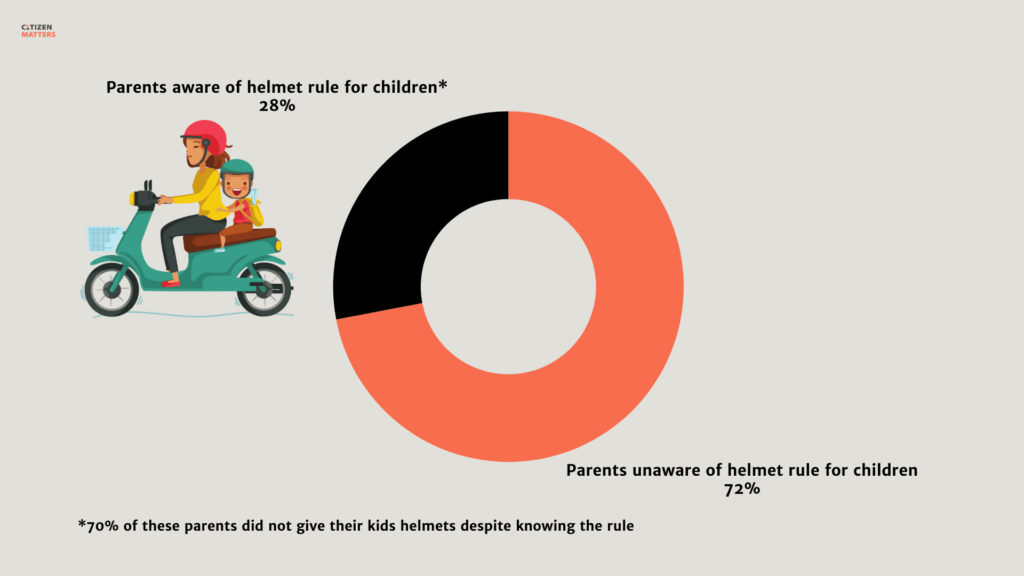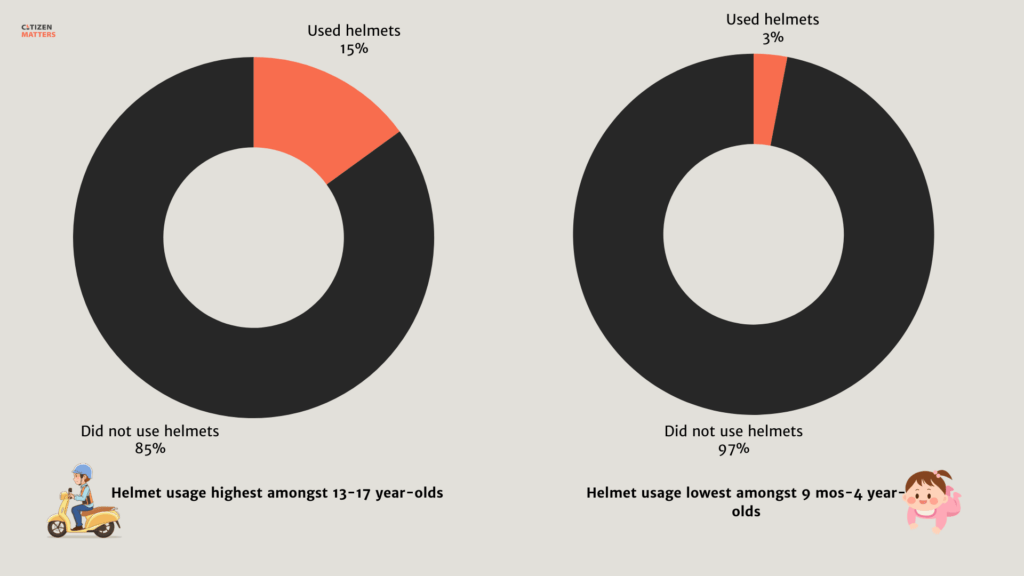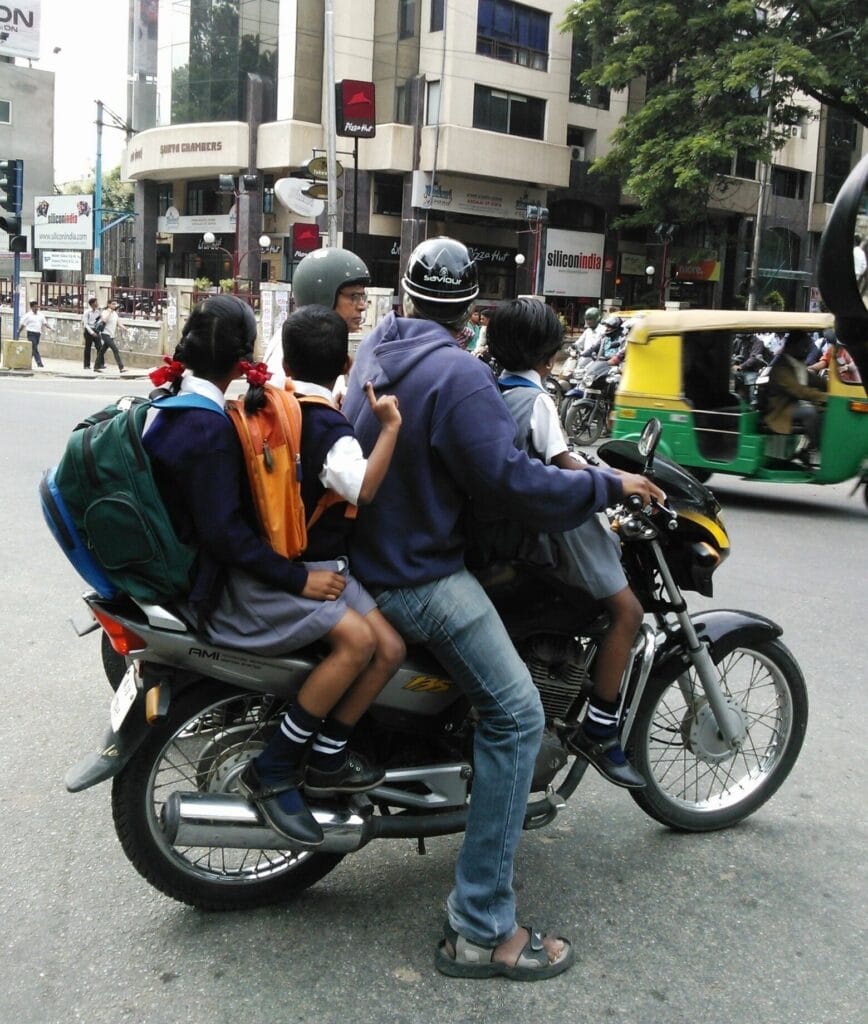As India experiences economic growth, the accompanying rise in motorisation and vehicular traffic brings a heightened risk of road crash injuries and fatalities. With two-wheelers dominating Indian roads (these comprise 75% of all registered vehicles), the safety of their riders, particularly children, becomes paramount. Road crashes often stem from non-compliance with traffic rules, inadequate infrastructure, and lack of safety gear, with helmets being a critical yet frequently overlooked safety aspect.
In Tamil Nadu, two-wheelers accounted for the highest fatalities (44.22%) in 2023. Around 29.9% of these fatalities were attributed to non-compliance with helmet usage. According to the World Health Organization (WHO), wearing a helmet correctly can reduce the risk of injuries by 42% and head injuries by 69%.
Read more: Staying safe while driving on Chennai roads this monsoon
Safety regulations on the road for children
Section 129 of the Motor Vehicles (Amendment) Act of 2019 requires everyone over four years riding on a two-wheeler to wear a helmet that meets the standards prescribed by the Bureau of Indian Standards (BIS). This provision encompasses drivers and pillion riders, including children. However, adherence to this law is poor, with many riders neglecting helmet use while failing to instil this habit in their children. This lack of compliance contributes significantly to the vulnerability of young passengers.
Globally, road traffic injuries are the leading cause of death for children aged 5–19 years. In India, the 2022 Road Accidents report highlighted that 9,528 road-related fatalities involved children under 18. With two-wheelers often being the primary mode of transport for low and middle-income families, prohibiting children from riding on them is impractical. However, the safety of these young passengers can be greatly improved through the enforced use of appropriate safety gear.
To protect children under four years old on two-wheelers, the government introduced the Central Motor Vehicles (Second Amendment) Rules (CMVR 2022). This rule mandates that children between nine months and four years must wear a safety harness and either a crash helmet or a bicycle helmet, meeting American or European standards until BIS sets specific standards. A safety harness should attach the child to the motorcycle’s driver. Despite this regulation, enforcement has yet to begin.
Current trends in child helmet usage
A study by Citizen consumer and civic action Group (CAG), conducted between December 2023 and January 2024 surveyed 520 parents and 145 helmet shops in Chennai. The study revealed that only 25% of children wore helmets, with 12% using adult helmets. Around 28% of the parents were unaware of the helmet rule for children. Even among those parents who were aware of the rule (373 respondents), 70% admitted that their children didn’t wear helmets on two-wheelers.


Legally, carrying more than two people on a two-wheeler is prohibited, yet it is common to see children wedged between adults or perched precariously on the fuel tank. This practice complicates the use of helmets due to the lack of space and parents’ overestimation of their ability to protect their children during a crash.
Design and certification challenges
CAG’s study showed helmet usage was highest among children aged 13–17 (15%) and lowest among those aged 9 months to 4 years (3%). The low usage among younger children is often due to the unavailability of appropriately sized helmets. Among the helmet shops surveyed, 77% did not stock children’s helmets. Those that did typically offered only generic sizes.

The IS 4151 guidelines by BIS specify helmet sizes but do not address the unique needs of children’s helmets. Young children have different physiological requirements, with their heads being 90% the size of an adult’s by age four, but with less strength in their necks and incomplete skull bone development. BIS needs to focus on design aspects like weight, ventilation, and size to ensure helmets are suitable for children, especially those aged 9 months to 4 years.
According to the Helmet for Riders of Two Wheeler Motor Vehicles (Quality Control) Order, 2020, helmets must have an ISI certification mark. However, 26% of parents were unaware of this certification. Despite helmet shops knowing about ISI certification, 9% admitted to selling non-ISI-certified helmets, undermining safety standards. Enforcement against the sale of non-certified helmets is crucial.
We found that surveyed helmet shops primarily offered full-face and half-face helmets, followed by half-shell helmets. According to ISI standards, certified helmets must fully cover the head, neck, ears, and jaws. Half-shell helmets don’t meet these standards, making their sale illegal. However, shops continue to sell them as parents often opt for these cheaper options, not realising they are compromising their children’s safety.
Barriers to helmet use

Parents cited difficulty finding the right size, the cost, and the belief that their children were too young for helmets. Among the 145 shops surveyed, only 54% sold helmets for children. We found that in nearly half of the shops selling helmets, sales were quite low averaging between 0-10 helmets per month.
The unavailability of helmets deters their usage, creating a cycle where low demand leads to low supply. The Tamil Nadu Transport and Road Safety Commission should intervene to increase the production and availability of standardised helmets.
Perception of risk also plays a role. Parents who have not experienced or witnessed severe accidents may underestimate the importance of helmets, believing their driving skills or vehicle safety features are sufficient. Affordability is another issue, with children’s helmets costing between ₹500 and ₹1000. However, compared to the potential medical costs of a crash, or the amount spent purchasing a vehicle, the cost of a helmet should be viewed by parents rationally, as a cost-effective safety measure.
Protect our young riders
Research shows that combining road safety education with law enforcement significantly improves helmet usage. Strict enforcement of child helmet laws, along with education and awareness initiatives, is essential. Integrating road safety education into school curriculums can help inculcate the importance of helmets from a young age.
The debate on whether children should be passengers on two-wheelers continues, but in the interim, enforcing mandatory helmet use can significantly reduce fatalities. Promoting public transport as a safer alternative remains a long-term goal. Enforcing helmet laws for children aligns with India’s goal of halving road fatalities by 2030, making it a crucial step towards safer roads.
[Read the full report here: The helmet conundrum – An assessment of child helmet usage and availability in Chennai | CAG]
Such an important reminder about child helmets! It’s shocking how often this critical gear is overlooked when it could literally save lives. Road safety starts with small but essential precautions like this. Let’s prioritize our kids’ safety by making helmets a non-negotiable part of their gear!